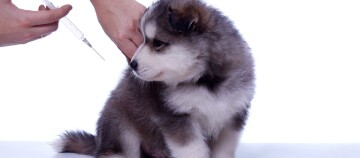Puppy Growth Chart - Everything You Need to Know About Dog Growth
03.01.2023 - Reading time: 3 minutes

When you raise a puppy, you will be amazed at how fast it grows. This is because the young dog is in its main growth phase from the third to the seventh month. This article tells you everything you need to know about dog growth.
Depending on the breed and size of the puppy, growth takes place in phases of vary. Small dog breeds are already fully grown at eight months, whereas it can take up to two years for very large breeds to reach this stage. A dog’s growth curve shows how fast it should ideally grow and how much weight it should put on. Using these dog growth curves, the vet checks whether it is developing healthily according to its age.
Why healthy growth is so important
There are two crucial factors for healthy growth. Your dog should be the right weight to develop optimally, and should only be physically exercised to the extent that its skeleton and muscles are not overstressed. Especially in the first months of life, puppies develop a lot of muscle mass. At the same time, their skeletons are still very fragile. This is why it is important that you take it easy on the animal during this growth phase and, for example, hold it in your arms when climbing stairs. Long walks are also excluded in the first few months, not to mention running alongside a bicycle. As a rule of thumb, the puppy should walk for five minutes at a time for each month of its life.
Furthermore, a halthy, balanced diet is essential for puppies’ healthy growth. Too much food can cause the dog to grow too fast, which can have serious physical consequences that may be irreversible.
Puppy growth: balanced nutrition and ideal weight
As puppies grow, they only show signs of being overweight in extreme cases. This is because when young dogs are overfed, their bodies transforms this excess energy into growth. This in turn results in the puppy growing too fast. However, growth that is too rapid stops healthy joint and skeletal development. Large breeds of dogs are often affected by this. When dogs are unwittingly overfed, they usually gain weight by growing faster, but this not visible. This is why there are growth curves for dogs and why vets weigh your dog regularly and compares the values with the ideal curve for the dog breed.
Potentially harmful consequences of growing too rapidly
Overfeeding causes the skeleton to grow too fast and this can lead to physical defects. For example, cartilage defects or uneven bone growth can occur. Overfeeding can also promote hip dysplasia.
Using the growth curve of the dog to detect nutritional errors
If there are irregularities in the growth curve, it is best to consult your vet. Perhaps you were fooled by your puppy’s slim build and fed it a little more than indicated on the food package? You may also have forgotten to subtract the amount of treats from the total amount of food. The same applies to the use of a dummy filled with normal dog food for training, but the amount of this food has also not been added to the daily food ration. If you (or your vet) regularly compare your pet’s development with a growth chart for puppies, feeding mistakes like these can be avoided.


